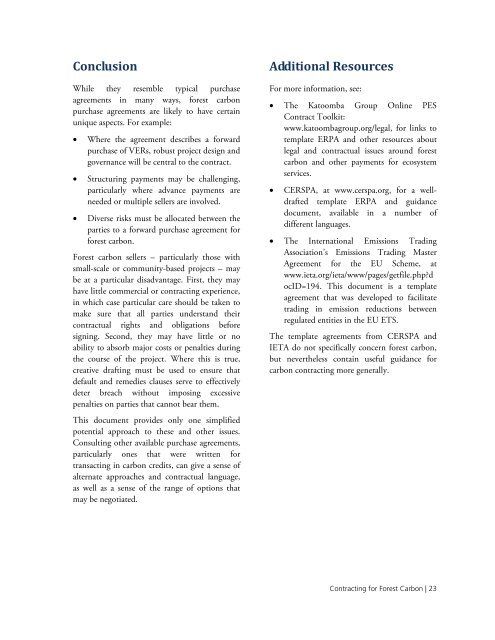Contracting for Forest Carbon : Elements of a Model ... - Forest Trends
Contracting for Forest Carbon : Elements of a Model ... - Forest Trends
Contracting for Forest Carbon : Elements of a Model ... - Forest Trends
You also want an ePaper? Increase the reach of your titles
YUMPU automatically turns print PDFs into web optimized ePapers that Google loves.
Conclusion<br />
While they resemble typical purchase<br />
agreements in many ways, <strong>for</strong>est carbon<br />
purchase agreements are likely to have certain<br />
unique aspects. For example:<br />
• Where the agreement describes a <strong>for</strong>ward<br />
purchase <strong>of</strong> VERs, robust project design and<br />
governance will be central to the contract.<br />
• Structuring payments may be challenging,<br />
particularly where advance payments are<br />
needed or multiple sellers are involved.<br />
• Diverse risks must be allocated between the<br />
parties to a <strong>for</strong>ward purchase agreement <strong>for</strong><br />
<strong>for</strong>est carbon.<br />
<strong>Forest</strong> carbon sellers – particularly those with<br />
small-scale or community-based projects – may<br />
be at a particular disadvantage. First, they may<br />
have little commercial or contracting experience,<br />
in which case particular care should be taken to<br />
make sure that all parties understand their<br />
contractual rights and obligations be<strong>for</strong>e<br />
signing. Second, they may have little or no<br />
ability to absorb major costs or penalties during<br />
the course <strong>of</strong> the project. Where this is true,<br />
creative drafting must be used to ensure that<br />
default and remedies clauses serve to effectively<br />
deter breach without imposing excessive<br />
penalties on parties that cannot bear them.<br />
This document provides only one simplified<br />
potential approach to these and other issues.<br />
Consulting other available purchase agreements,<br />
particularly ones that were written <strong>for</strong><br />
transacting in carbon credits, can give a sense <strong>of</strong><br />
alternate approaches and contractual language,<br />
as well as a sense <strong>of</strong> the range <strong>of</strong> options that<br />
may be negotiated.<br />
Additional Resources<br />
For more in<strong>for</strong>mation, see:<br />
• The Katoomba Group Online PES<br />
Contract Toolkit:<br />
www.katoombagroup.org/legal, <strong>for</strong> links to<br />
template ERPA and other resources about<br />
legal and contractual issues around <strong>for</strong>est<br />
carbon and other payments <strong>for</strong> ecosystem<br />
services.<br />
• CERSPA, at www.cerspa.org, <strong>for</strong> a welldrafted<br />
template ERPA and guidance<br />
document, available in a number <strong>of</strong><br />
different languages.<br />
• The International Emissions Trading<br />
Association’s Emissions Trading Master<br />
Agreement <strong>for</strong> the EU Scheme, at<br />
www.ieta.org/ieta/www/pages/getfile.php?d<br />
ocID=194. This document is a template<br />
agreement that was developed to facilitate<br />
trading in emission reductions between<br />
regulated entities in the EU ETS.<br />
The template agreements from CERSPA and<br />
IETA do not specifically concern <strong>for</strong>est carbon,<br />
but nevertheless contain useful guidance <strong>for</strong><br />
carbon contracting more generally.<br />
<strong>Contracting</strong> <strong>for</strong> <strong>Forest</strong> <strong>Carbon</strong> | 23
















